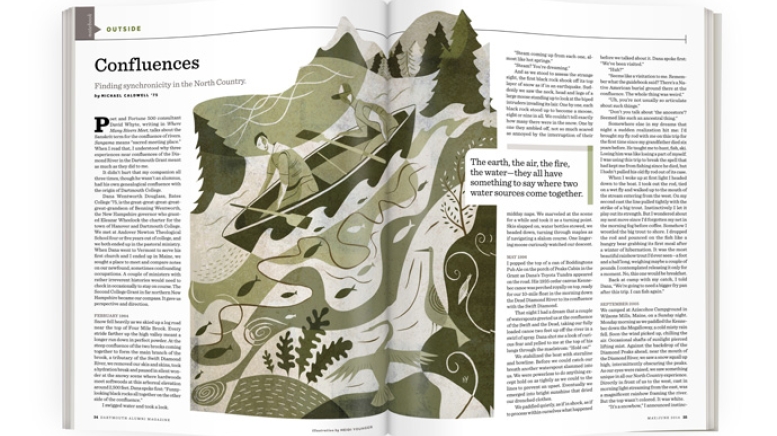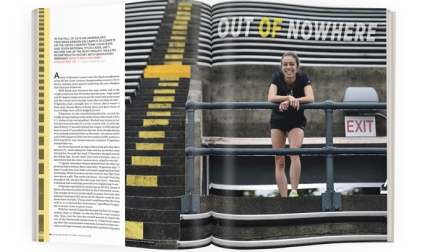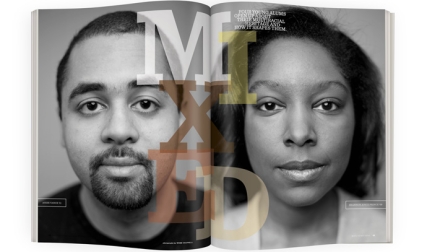Poet and Fortune 500 consultant David Whyte, writing in Where Many Rivers Meet, talks about the Sanskrit term for the confluence of rivers. Sangama means “sacred meeting place.” When I read that, I understood why three experiences near confluences of the Diamond River in the Dartmouth Grant meant as much as they did to me.
It didn’t hurt that my companion all three times, though he wasn’t an alumnus, had his own genealogical confluence with the origin of Dartmouth College.
Dana Wentworth Douglass, Bates College ’75, is the great-great-great-great-great-grandson of Benning Wentworth, the New Hampshire governor who granted Eleazar Wheelock the charter for the town of Hanover and Dartmouth College. We met at Andover Newton Theological School four or five years out of college, and we both ended up in the pastoral ministry. When Dana went to Vermont to serve his first church and I ended up in Maine, we sought a place to meet and compare notes on our newfound, sometimes confounding occupations. A couple of ministers with rather irreverent histories would need to check in occasionally to stay on course. The Second College Grant in far northern New Hampshire became our compass. It gave us perspective and direction.
February 1984
Snow fell heavily as we skied up a log road near the top of Four Mile Brook. Every stride farther up the high valley meant a longer run down in perfect powder. At the steep confluence of the two brooks coming together to form the main branch of the brook, a tributary of the Swift Diamond River, we removed our skis and skins, took a hydration break and paused in silent wonder at the snowy scene where hardwoods meet softwoods at this arboreal elevation around 2,500 feet. Dana spoke first: “Funny- looking black rocks all together on the other side of the confluence.”
I swigged water and took a look.
“Steam coming up from each one, almost like hot springs.”
“Steam? You’re dreaming.”
And as we stood to assess the strange sight, the first black rock shook off its top layer of snow as if in an earthquake. Suddenly we saw the neck, head and legs of a large moose standing up to look at the biped intruders invading its lair. One by one, each black rock stood up to become a moose, eight or nine in all. We couldn’t tell exactly how many there were in the snow. One by one they ambled off, not so much scared as annoyed by the interruption of their midday naps. We marveled at the scene for a while and took it as a turning point. Skis slapped on, water bottles stowed, we headed down, turning through maples as if navigating a slalom course. One lingering moose curiously watched our descent.
May 1996
I popped the top of a can of Boddingtons Pub Ale on the porch of Peaks Cabin in the Grant as Dana’s Toyota Tundra appeared on the road. His 1935 cedar canvas Kennebec canoe was perched royally on top, ready for our 10-mile float in the morning down the Dead Diamond River to its confluence with the Swift Diamond.
That night I had a dream that a couple of waterspouts greeted us at the confluence of the Swift and the Dead, taking our fully loaded canoe two feet up off the river in a swirl of spray. Dana shot me a look of curious fear and yelled to me at the top of his lungs through the maelstrom: “Hold on!”
We stabilized the boat with sternline and bowline. Before we could catch our breath another waterspout slammed into us. We were powerless to do anything except hold on as tightly as we could to the lines to prevent an upset. Eventually we emerged into bright sunshine that dried our drenched clothes.
We paddled quietly, as if in shock, as if to process within ourselves what happened before we talked about it. Dana spoke first: “We’ve been visited.”
“Huh?”
“Seems like a visitation to me. Remember what the guidebook said? There’s a Native American burial ground there at the confluence. The whole thing was weird.”
“Uh, you’re not usually so articulate about such things.”
“Don’t you talk about ‘the ancestors’? Seemed like such an ancestral thing.”
Somewhere else in my dreams that night a sudden realization hit me: I’d brought my fly rod with me on this trip for the first time since my grandfather died six years before. He taught me to hunt, fish, ski. Losing him was like losing a part of myself. I was using this trip to break the spell that had kept me from fishing since he died, but I hadn’t pulled his old fly rod out of its case.
When I woke up at first light I headed down to the boat. I took out the rod, tied on a wet fly and walked up to the mouth of the stream entering from the west. On my second cast the line pulled tightly with the strike of a big trout. Instinctively I let it play out its strength. But I wondered about my next move since I’d forgotten my net in the morning fog before coffee. Somehow I wrestled the big trout to shore. I dropped the rod and pounced on the fish like a hungry bear grabbing its first meal after a winter of hibernation. It was the most beautiful rainbow trout I’d ever seen—a foot and a half long, weighing maybe a couple of pounds. I contemplated releasing it only for a moment. No, this one would be breakfast.
Back at camp with my catch, I told Dana, “We’re going to need a bigger fry pan after this trip. I can fish again.”
September 2005
We camped at Aziscohos Campground in Wilsons Mills, Maine, on a Sunday night. Monday morning as we paddled the Kennebec down the Megalloway, a cold misty rain fell. Soon the wind picked up, chilling the air. Occasional shafts of sunlight pierced lifting mist. Against the backdrop of the Diamond Peaks ahead, near the mouth of the Diamond River, we saw a snow squall up high, intermittently obscuring the peaks. As our eyes were raised, we saw something unique in all our North Country experience. Directly in front of us to the west, cast in morning light streaming from the east, was a magnificent rainbow framing the river. But the top wasn’t colored. It was white.
“It’s a snowbow,” I announced instinctively from the bow. I put my paddle across the gunwales to take in the sight. My stern partner doubted me at first.
“How do you figure?”
“Look. It’s misting here at river level. So we see the rainbow’s sides. We can’t see its top because the sunlight can’t refract through the snow like it can through rain. It’s a rainbow with its top curl in the snow at a higher elevation where the temperature is below freezing. It’s a snowbow.”
He was quiet for a while, ruddering more than paddling. Finally he spoke.
“You’re right.”
Before long it faded as clouds obscured the sun again. We were quiet for a while before paddling again. Then I spoke up.
“You know how Noah took the rainbow after the flood to be a sign of hope?”
“Yeah. He thought it meant there’d never be another flood destroying the earth.”
“Well, why couldn’t the snowbow mean there’d never be any more destruction of earth from any source. I mean, we’re vulnerable now to a lot more than floods: climate change, the continuing nuclear threat, chemical and biological warfare and all kinds of other environmental degradation. We could interpret the snowbow to mean earth won’t be compromised by anything any more than it already is.”
“Dream on.”
He wasn’t ready to hear me. But I believed it right away. It was a confluence moment. Something bigger than both of us spoke as loudly as the magical moose, as loudly as the waterspouts. The earth, the air, the fire (the sun), the water—they all seemed to have something to say where two water sources come together. Jung called it synchronicity, Native people called it, simply, Spirit. Moses, Jesus and Mohammed knew its power as Elohim or Allah.
Why did the ancients give special names to the confluences of rivers? Why did they bury their dead there? Today Dana and I often compare our lives to the flow of rivers into one another, adding volume and quality of life. We hope we too broaden with greater perspective into bays. There our downstream flow may stop, but future travelers may pick up our insights in the collective unconsciousness of the ancestors’ breath in the sounds of the waves.
Michael Caldwell is a maple sugar-maker, soccer official, backcountry skier and Congregational pastor in North Wolcott, Vermont.




